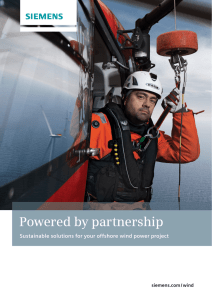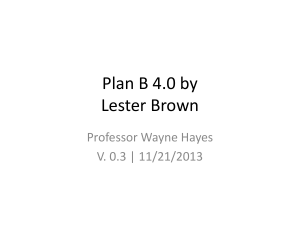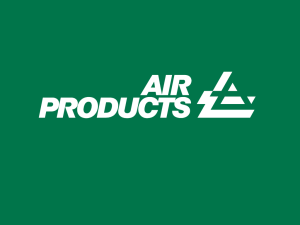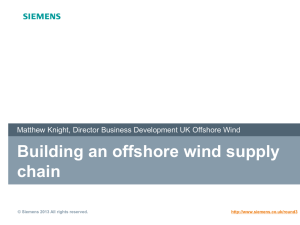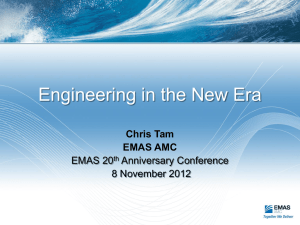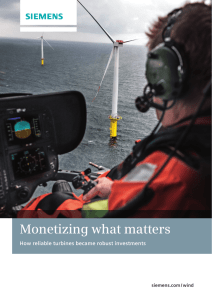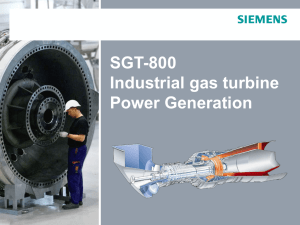Thomas Mousten - Siemens
advertisement
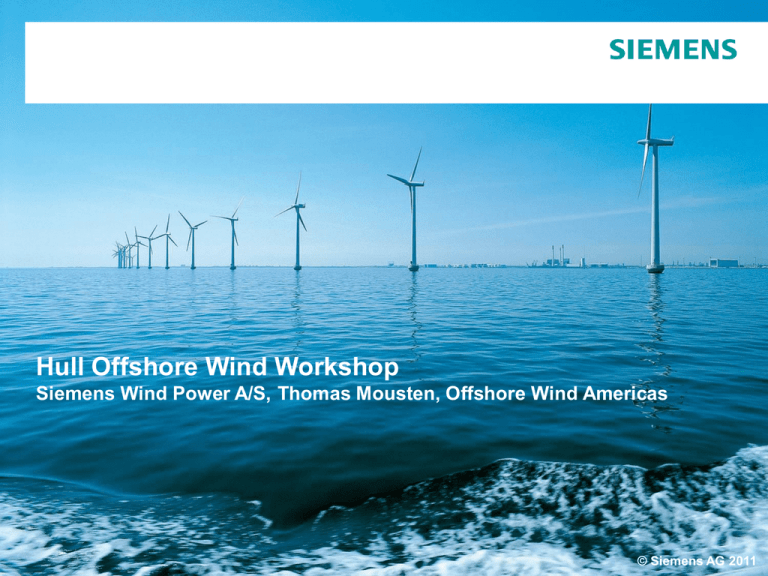
Hull Offshore Wind Workshop Siemens Wind Power A/S, Thomas Mousten, Offshore Wind Americas © Siemens AG 2011 Divisions Industry Industry Automation Drive Technologies Osram Industry Solutions Building Technologies Mobility Oil & Gas Fossil Power Generation Renewable Energy Energy Service Power Transmission Power Distribution Healthcare Sectors Energy Answers provided by 15 Divisions in three Sectors Imaging & IT Workflow & Solutions Diagnostics © Siemens AG 2011 We are globalizing our offshore expertise and are ready to serve the US market Map of Siemens offshore offices Netherlands (Den Hague) UK (Frimley) Denmark, HQ (Brande) North America (Boston) China (Beijing) Germany (Hamburg) Q 2 2 Q 010 3 2 Q 010 4 2 Q 010 1 2 Q 011 2 2 Q 011 3 2 Q 011 4 20 11 14 12 10 8 6 4 2 0 © Siemens AG 2011 Trends in Offshore Wind Turbine Technology -Hub height & Rotor sizes WTG’s are getting larger and are installed farther off shore and in locations with deeper water depths The turbine towers are becoming taller as a consequence of the larger rotors. Financial modeling also shows benefits from taller towers due to better wind resources but is also associated with higher costs for foundation and tower construction. Longer and Lighter Blades The offshore wind industry is currently offering blades in the 120m range Rotor Diameter Range (m) Rating (MW) Distance to shore (km) Water depths (m) Size of offshore wind farms (MW) 1990s 2000s 2010s 2020s 37 82 120 >150 0,5 3 3,6 >6 2 12 35 > 70 5 15 > 30 > 30 6 90 > 500 open Indications are pointing towards rotors in the >150m range for offshore turbines. Siemens Wind Power followed this trend with the SWT 3.6-120MW Tests indicate that the new machine will generate approx. 10% more electricity in comparison to similar wind turbines. © Siemens AG 2011 Trends in Offshore Wind Turbine Technology -Optimization of Availability Turbine Condition Monitoring (TCM®) The TCM® system allows for the continuous online vibration monitoring of the wind turbine with 6 sensors and allows for the assessment of: Gearbox Main bearing Generator The purpose of the TCM® system is to: Optimize the planning of service works, reduce service costs and down time Perform preventive repair of components before breakdown – automatic stop of wind turbine in case of excess of vibration limits Improves possibilities for further technical development © Siemens AG 2011 Our strategy for technology leadership SWT-3.0-101 Facts 3.0 MW gearless direct drive turbine Rotor diameter: 101 m No gear box Reduced number of parts Reduced maintenance costs Synchronous permanent magnet generator High efficiency Compact design allows for easier transportation and installation Picture from installation to follow The 6-MW direct drive wind turbine will be launched later this year Will be particularly suitable for large offshore wind power plants © Siemens AG 2011 Trends in Offshore Wind Turbine Technology -Foundations Foundation : monopiles not necessarily the suitable solution Foundation type Cost saving potential Monopiles Monopiles Water depth (m) Known technology Foundation type Monopiles 0 - 10 Gravity Gravity Gravity Known technology Monopiles 10 - 35 Less steel Jackets Jackets Jackets Stiffer structure Jackets Not yet industrialized From 35 Floating Floating Potential future concept for deep positions Floating (future) Tower interface : two potential cost saving solutions Having one structure: More even distribution of stiffness steel reduction Improving arrangements (secondary steel): Specific offshore interface design (flanges, platforms, lay down area, access, etc) steel reduction © Siemens AG 2011 Hywind: An example of how we are tackling trends in offshore wind Hywind Cooperation on technology with Statoil to develop the world's first floating offshore installation In 2009 Siemens installed the first wind turbine for the demonstration unit off the coast of Norway Floating offshore turbines could be installed at sites with greater water depths Source: SWP © Siemens AG 2011 Trends in the offshore Balance of Plant -Vessels Future vessels need to be… Able to install turbine quickly Able to install pre-commissioned components Working year round even in high down time period Designed for specific purpose Purpose build vessel is a key component in a project To ensure vessel availability in the US: Short term the Jones Act needs to allow for foreign build vessels; either in general or be project specific waivers Long term U.S. shipyards and/or ship operators should team up with European experience and start installation vessels development in the U.S. © Siemens AG 2011 Trends in the offshore Balance of Plant -Ports Offshore port requirements: Unrestricted access to, and permit to work in the area, 24/7 and 365 days a year A contiguous piece of level land with a total area of 2000 m2 per turbine (min. 50000 m2) Suitable water depths at the load-in quay of ~ 10m allowing ocean-going coasters (cargo vessels) Indoor high ceiling storage Good infrastructure within the construction area and the quay side Utilities: Power, water, internet and phone © Siemens AG 2011 Thank you very much for your attention! Questions? © Siemens AG 2011


